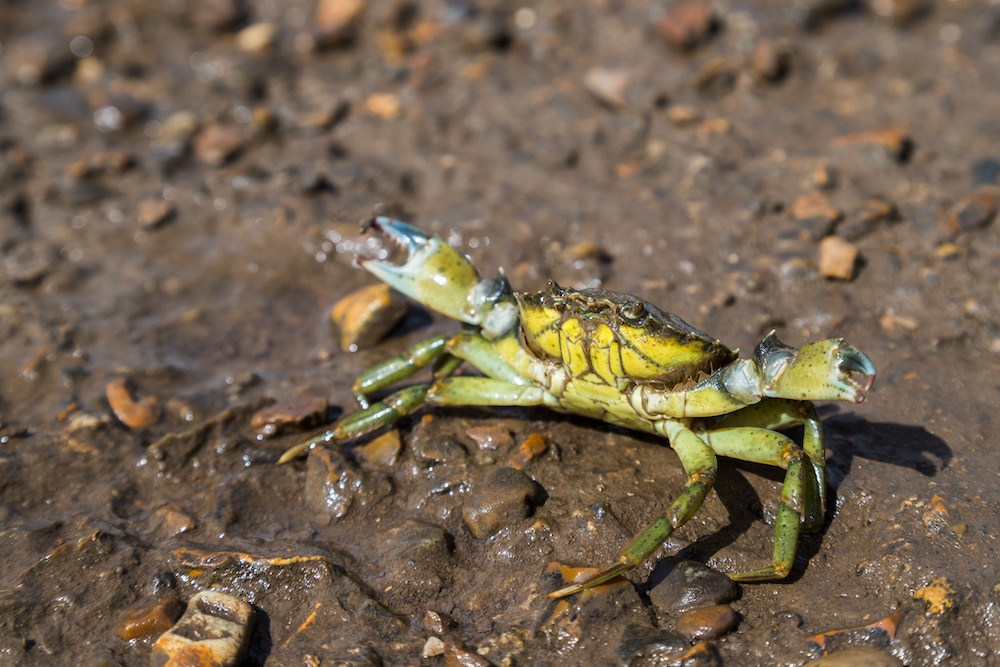Create a free profile to get unlimited access to exclusive videos, sweepstakes, and more!
An army of green crabs are poised to invade Alaska
They're armored and they have weapons.

In the documentary series Alien Invasion: Are We Ready? (now streaming on Peacock!) scientists and military specialists imagine what an actual alien invasion might look like. Ever since the idea of potential extraterrestrial intelligence hit the mainstream, we have been low-key obsessed with thinking about how events might unfold and what, if anything, we could do to stop an invasion. Countless books, movies, and video games explore the question, and the genre probably isn’t going away.
While we’ve had our eyes to the skies, however, we’ve been experiencing a slower and more mundane invasion here on the ground. Or, more accurately, in the water. Over the last couple of centuries, a growing army of European green crabs has slowly been making its way across North America and it appears as though they’re marching on a new front. They're well-equipped too. Crabs seem to be nature's favorite form. Through invasion or evolution, we're all destined to be crabs one day... maybe.
European green crabs first appeared in the America’s roughly 200 years ago, probably as a consequence of colonization. For most of the intervening time, they’ve largely been isolated to the East Coast. Large swaths of land aren’t the typical hang out spots for most crabs, so our Pacific shores were safe. Or so we thought. But like the elves of Middle-earth, the green crabs had their stalky eyes ever on the west.
In the 1980s, they appeared seemingly overnight in San Francisco Bay. It’s unlikely that they made their way across the country on land or traveled around by water. Instead, this is probably a problem of our own making. It’s believed the crabs were carried to California, possibly as bait. However they got there, they quickly set to work multiplying.
Even still, their progress was slow at first. It took them until 2016 to make their way up the coast to inland Washington. Since then, tens of thousands of crabs have been captured and, despite a multimillion-dollar population control program, they’re probably there to stay.
Then, over the course of only four years, they spread from Washington into British Columbia. Two years later, in the summer of 2022, they reached the southern tip of Alaska. In July, an intern for NOAA was walking along the shores of the Metlakatla Indian Community when they discovered a shell, the first sign that European green crabs were in the area. Then people found a few more shells. Soon after, people started seeing live crabs. Dozens of them.
Scientists believe this accelerated population spread, moving continually northward, was probably driven by climate change. As ecosystems change, species follow the shifting band of temperature and move into new areas. There are concerns that the presence of the crabs will disrupt local ecosystems by outcompeting existing species for resources or eating them directly.
Particularly, scientists and conservationists are concerned for the eel grass meadows in Alaska. Eel grass meadows are a critical environment and resource both for native Dungeness crabs and Pacific salmon. Those animals, in turn, are an important part of the local economy and food supply.
While the current number of green crabs is comparatively low, the environments farther south serve as a portent for what Alaska will likely endure in coming years. Green crabs are an invasive species which has proven to be incredibly difficult to deal with. According to reports, the European green crab has never been successfully removed from any ecosystem where it establishes a population. Worse, establishing a population is relatively easy for crabs.
After mating, female green crabs release nearly 20,000 eggs. Once those eggs hatch, they catch currents and spread anywhere the water will take them. Then they breed again, but first they have to find one another. There’s a critical moment, right when green crabs show up in an area, when we might feasibly be able to head them off. Once they reach a critical breeding population, it becomes a war of attrition we’re unlikely to win. Worse, the battlefield is so far-reaching. Alaska has more than 54,000 kilometers of shoreline just waiting for the crabs to slide in. Much of it is probably too cold or lacks some necessary resource, but if the trendline is any indicator, European green crabs are already making plans to keep moving on up.
The odds are we won’t succeed at keeping the crabs at bay. Much like our eventual alien invaders, the crabs are here to stay and we’re going to have to find a way to live together.


























